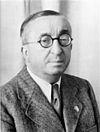German_National_Prize_for_Art_and_Science
German National Prize for Art and Science
Nazi German award
Through statutes of 30 January 1937,[1] the German Führer Adolf Hitler instituted the German National Order for Art and Science (German: Der Deutscher Nationalorden für Kunst und Wissenschaft)[1] as a replacement for the Nobel Prize (Hitler forbade Germans to accept the latter award after the Norwegian Nobel Committee awarded the 1935 Nobel Peace Prize retrospectively in November 1936 to an anti-Nazi German writer, Carl von Ossietzky.) The German National Prize was to be awarded each year to three outstanding German citizens who would each receive 100,000 Reichsmarks which could be equally divided.[1] Along with the prize money the recipient also received a certificate with the Order.[2]
The badge of the Order, a round four-pointed platinum star with four gold National Eagles attached, was designed by Berlin sculptor Hermann Müller-Erfurt.[1][need quotation to verify][3] It was to be worn on the left breast. In the centre is a medallion with a red enameled centre with the gold head of Pallas Athene. On an ivory-coloured enameled background in gold letters was the inscription FÜR KUNST UND WISSENSCHAFT (For Art and Science). This was surrounded by diamonds set in a gold border.[2]
The total number of National Prizes awarded between 1937 and 1939 was nine, making it the rarest award given in Nazi Germany. Due to the outbreak of the Second World War in Europe in 1939, no further awards were made.








